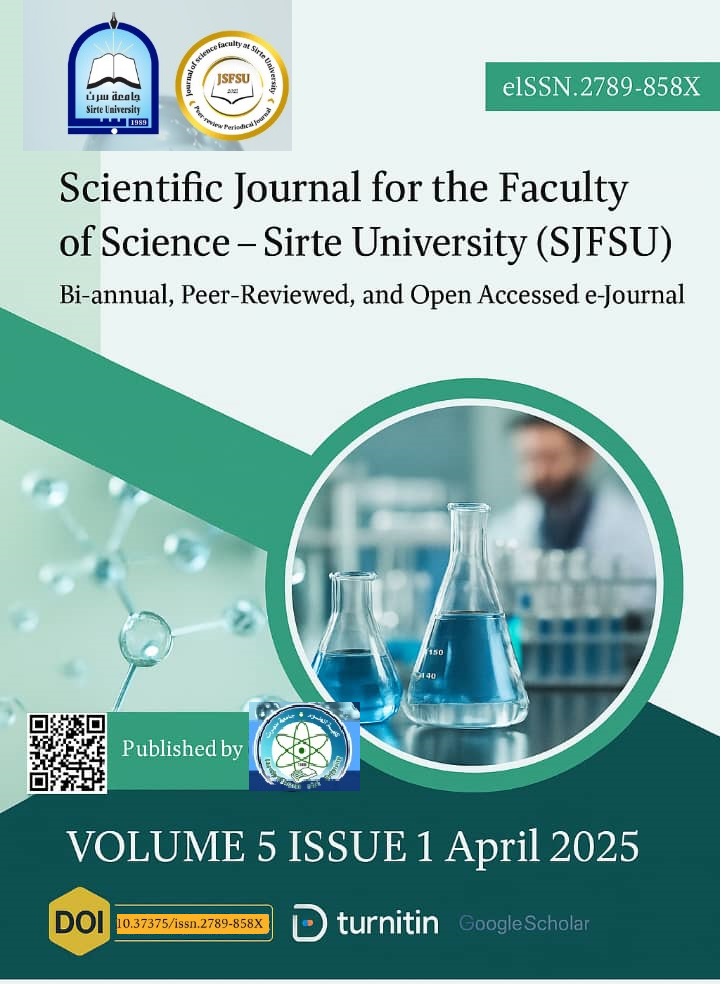The Effects of Polycystic Ovarian Syndrome on Pregnant Women
DOI:
https://doi.org/10.37375/sjfssu.v5i1.3211Keywords:
polycystic ovarian syndrome, , pregnant women, , congenital malformationAbstract
Polycystic ovary syndrome (PCOS) may be a differentiated glandular disease that affects body systems and causes metabolic and reproductive complications or disorders in women of childbearing age. The study was designed to know the criteria and symptoms that appear on women in the city of Mosul as a result of having polycystic ovarian syndrome PCOS. Objective :The aim of the study is a determine the incidence of the disease and its complications in the city of Mosul. Method : The study was conducted on a hundred seventy women , 35 of them were in the control group, whereas 135 of them were the affected women of various ages, The study included a number of criteria (social situation, age at which the infection occurred, whether pregnancy occurred without treatment, how long did it take to become pregnant after infection, did polycystic disease lead to infertility, did polycystic disease lead to abortion, did infection lead to birth defects, Symptoms accompanying the injury), Result : The results showed that the highest rate of infection was among married women, while the results showed that the highest percentage of the age at which the infection occurred was between 18-36 , and the results showed that pregnancy did not occur without treatment, in some cases it took several years for pregnancy to occur as a result of the syndrome. The disease led to infertility and abortion, and the most prominent symptoms were menstrual disorders, hirsutism, obesity and other symptoms. Conclusion: The incidence of polycystic ovaries is higher among married women, and it also induces missgrage , infertility and menstrual disorders, while the study did not find a significant increase in the proportion of deformed fetuses
References
Abd, Mai Nafie Younes. (2017).Study of the therapeutic effect of women with polycystic ovary syndrome on physiological and biochemical factors in the city of Tikrit and its suburbs, PhD thesis, Tikrit University, College of Education for Pure Sciences, Department of Life Sciences, Tikrit, Iraq.
Al-Dulaimi, Nour Thamer Hammoud. (2018). Study of some physiological and genetic variables among women with polycystic ovary syndrome in the city of Baghdad, master's thesis, Anbar University, College of Education for Pure Sciences, Department of Life Sciences, Anbar, Iraq.
Alemzadeh, R., Kichler, J., and Calhoun, M. (2010). Spectrum of metabolic dysfunction in relationship with hyperandrogenemia in obese adolescent girls with polycystic ovary syndrome. European journal of endocrinology, 162(6), 1093–1099. https://doi.org/10.1530/EJE-10-0205
Al-Hadithy, E. M. R.(2010) Role of Ultrasound and Hormones in the Study of polycystic ovarian syndrome, Egyptian Dental Journal;56(4):2341-2345.
Balen AH. (2007).Polycystic ovary syndrome and secondary amenorrhoea.In: Edmonds DK,editor. Dewhurt's Textbook of Obstetrics & Gynaecology. 7th ed.USA: Blackwell; P. 377-97.
Chaudhary N, Qamar I. (2016).Polycystic ovary syndrome: conditions, genetics and current cure. Endocrinol Metab Int J. ;3(5):107-112. DOI: 10.15406/emij.2016.03.00060
Duhig, K., Chappell, L. C., and Shennan, A. H. (2016). Oxidative stress in pregnancy and reproduction. Obstetric medicine, 9(3), 113–116. https://doi.org/10.1177/1753495X16648495
Dumesic, D. A., Oberfield, S. E., Stener-Victorin, E., Marshall, J. C., Laven, J. S., & Legro, R. S. (2015). Scientific Statement on the Diagnostic Criteria, Epidemiology, Pathophysiology, and Molecular Genetics of Polycystic Ovary Syndrome. Endocrine reviews, 36(5), 487–525. https://doi.org/10.1210/er.2015-1018
Fauser, B. C., Tarlatzis, B. C., Rebar, R. W., Legro, R. S., Balen, A. H., Lobo, R., Carmina, E., Chang, J., Yildiz, B. O., Laven, J. S., Boivin, J., Petraglia, F., Wijeyeratne, C. N., Norman, R. J., Dunaif, A., Franks, S., Wild, R. A., Dumesic, D., & Barnhart, K. (2012). Consensus on women's health aspects of polycystic ovary syndrome (PCOS): the Amsterdam ESHRE/ASRM-Sponsored 3rd PCOS Consensus Workshop Group. Fertility and sterility, 97(1), 28–38.e25. https://doi.org/10.1016/j.fertnstert.2011.09.024
Hoeger K. M. (2007). Obesity and lifestyle management in polycystic ovary syndrome. Clinical obstetrics and gynecology, 50(1), 277–294. https://doi.org/10.1097/GRF.0b013e31802f54c8.
Housman, E., and Reynolds, R. V. (2014). Polycystic ovary syndrome: a review for dermatologists: Part I. Diagnosis and manifestations. Journal of the American Academy of Dermatology, 71(5), 847.e1–858. https://doi.org/10.1016/j.jaad.2014.05.007.
Hugar , A., Kanjikar , A., Londonkar , R .(2018).Polycystic Ovary Syndrome (PCOS)-A Mini Review , Journal of Gynecology; Volume 3 Issue 1.
Jacob,R.;, Jude,A.L.C.; Chandrasekhar, R.;, Sasikala,K. (2014). Prevalence of Acne among women with Poly Cystic Ovarian. Scrutiny International Research Journal of Health and Medical;1(1)1-13.
Kareem , M., Al-Dujaily, S., Salman, M.(2017).CORRELATION BETWEEN SERUM AND FOLLICULAR FLUID ACTIVIN AND CLINICAL PREGNANCY RATES IN SUBFERTILE WOMEN UNDERGOING INTRACYTOPLASMIC SPERM INJECTION, World Journal of Pharmaceutical Research; 14 Vol 6, Issue.
Kollmann, M., Klaritsch, P., Martins, W. P., Guenther, F., Schneider, V., Herzog, S. A., Craciunas, L., Lang, U., Obermayer-Pietsch, B., Lerchbaum, E., and Raine-Fenning, N. (2015). Maternal and neonatal outcomes in pregnant women with PCOS: comparison of different diagnostic definitions. Human reproduction (Oxford, England), 30(10), 2396–2403. https://doi.org/10.1093/humrep/dev187.
March, W. A., Moore, V. M., Willson, K. J., Phillips, D. I., Norman, R. J., and Davies, M. J. (2010). The prevalence of polycystic ovary syndrome in a community sample assessed under contrasting diagnostic criteria. Human reproduction (Oxford, England), 25(2), 544–551. https://doi.org/10.1093/humrep/dep399
McCartney, Ch. R. Marshall. C.J . (2016).polycystic ovary syndrome .The New England Joumal of medicine; 375:54-64.
Melmed, S.; Casanueva, F.F.;Hoffman, A.R.;Kleinberg, D.L.; Montori, V.M.; Schlechte, J.A.; Wass, J.A. (2011).Endocrine Society. Diagnosis and treatment of hyper -prolactinemia: an Endocrine Society clinical practice guideline. J Clin Endo -crinol Metab;96(2):273-88. Review
Mofid, A.; Seyyed ,A.; Zondieh ,S and Yazdani,T. (2007).HirsutismInt.Int.J.clin. Prac;62(3):433-443.
Moran, L. J., Hutchison, S. K., Norman, R. J., and Teede, H. J. (2011). Lifestyle changes in women with polycystic ovary syndrome. The Cochrane database of systematic reviews, (2), CD007506. https://doi.org/10.1002/14651858.CD007506.pub2
Niu, Z., Lin, N., Gu, R., Sun, Y., and Feng, Y. (2014). Associations between insulin resistance, free fatty acids, and oocyte quality in polycystic ovary syndrome during in vitro fertilization. The Journal of clinical endocrinology and metabolism, 99(11), E2269–E2276. https://doi.org/10.1210/jc.2013-3942.
Setji, T. L., and Brown, A. J. (2007). Polycystic ovary syndrome: diagnosis and treatment. The American journal of medicine, 120(2), 128–132. https://doi.org/10.1016/j.amjmed.2006.06.029
Shibli-Rahhal, A., and Schlechte, J. (2011). Hyperprolactinemia and infertility. Endocrinology and metabolism clinics of North America, 40(4), 837–846. https://doi.org/10.1016/j.ecl.2011.08.008
Speroff,L.and Fritz,M.A. (2005).Clinical gynecologic endocrinology and Infertility 7th ed.Lippincott Williams and Willkins comp.VSA ; pp 1014_1276.
Stein, I.F. and Leventhal, M.L. (1935).Amenorrhea associated with bilateral polycystic ovaries. American Journal of Obstetrics and Gynecology ;29- 181.
Suresh, S., and Vijayakumar, T. (2015). Correlations of Insulin Resistance and Serum Testosterone Levels with LH:FSH Ratio and Oxidative Stress in Women with Functional Ovarian Hyperandrogenism. Indian journal of clinical biochemistry : IJCB, 30(3), 345–350. https://doi.org/10.1007/s12291-014-0447-z
Tahir, A., Hussein, B. (2017).Salivary High Sensitive C-Reactive Protein and Gingival Health Status among a Group of Women with Polycystic Ovary Syndrome; Vol.:13 No.:1.
Tam Le, M., Van Nguyen, T., Thanh Nguyen, T., Thanh Thi Nguyen, T., An Thi Nguyen, T., Huy Vu Nguyen, Q., & Thanh Cao, N. (2019). Does polycystic ovary syndrome affect morphokinetics or abnormalities in early embryonic development?. European journal of obstetrics & gynecology and reproductive biology: X, 3, 100045. https://doi.org/10.1016/j.eurox.2019.100045
Teede, H., Deeks, A., and Moran, L. (2010). Polycystic ovary syndrome: a complex condition with psychological, reproductive and metabolic manifestations that impacts on health across the lifespan. BMC medicine, 8, 41. https://doi.org/10.1186/1741-7015-8-41.
Trikudanathan S. (2015). Polycystic ovarian syndrome. The Medical clinics of North America, 99(1), 221–235. https://doi.org/10.1016/j.mcna.2014.09.003
Upton,D.,H. (2016).Follicle Stimulating Hormone: Ovarian Reproductive Function, Health And Aging. PhD.University of Sydneyز
Xiao, S., Li, Y., Li, T., Chen, M., Xu, Y., Wen, Y., & Zhou, C. (2014). Evidence for decreased expression of ADAMTS-1 associated with impaired oocyte quality in PCOS patients. The Journal of clinical endocrinology and metabolism, 99(6), E1015–E1021. https://doi.org/10.1210/jc.2013-4177.
Yousouf,R.; Khan,M.; Kounsar,Z.; Ahangar,S.; Lone,W.A. (2012).Polycystic Ovarian Syndrome: Clinical Correlation with Biochemical Status. Surgical Science, 3, 245-248.
Zangana, Shireen Shehab Ahmed. (2019).A hormonal and molecular study of the relationship of inhibin A hormone with polycystic ovary syndrome, master's thesis, Samarra University, College of Education, Department of Life Sciences, Samarra, Iraq.

Downloads
Published
Issue
Section
License
Copyright (c) 2025 Scientific Journal for Faculty of Science-Sirte University

This work is licensed under a Creative Commons Attribution 4.0 International License.













